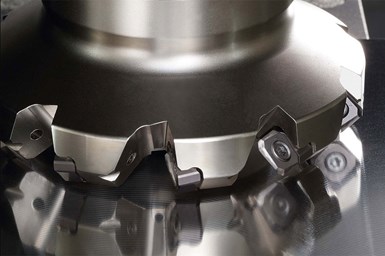Kyocera Milling Tool Provides Reliable Cutting Performance
The MB45 series is designed to cater to a broad spectrum of machining applications, giving customers a cost-effective solution for a wider range of possibilities.
Share





Kyocera SGS Precision Tools’ MB45 Milling Series for general purpose milling features economical eight-edge inserts and a new helical body design, giving users a more durable and versatile cutter with better finish capabilities over conventional mills.
The MB45 series of milling cutters provide durable, reliable performance when used in general machining applications or for more specialized solutions. The MB45 series delivers the low cutting force benefits of positive inserts and the fracture resistance of negative inserts, providing an optimal surface finish, while making it well suited for smaller machining centers. The series is designed to cater to a broad spectrum of machining applications, giving customers a cost-effective solution for a wider range of possibilities.
The MB45 series is enhanced by Kyocera’s new PR18 Series physical vapor deposition (PVD) coating, which extends tool life. These grades incorporate Megacoat Nano EX coating technology, which, in some cases, double the resistance and durability, according to the company. By using a specialized double-lamination technique with special nano multi-layers for abrasion, wear and heat resistance, this coating surpasses conventional grades, delivering superior performance and extending the lifespan of the tools.
Related Content
-
How to Troubleshoot Issues With Tool Life
Diagnosing when a tool is failing is important because it sets an expectation and a benchmark for improvements. Finding out why gives us a clue for how to fix it.
-
Finding the Right Tools for a Turning Shop
Xcelicut is a startup shop that has grown thanks to the right machines, cutting tools, grants and other resources.
-
Orthopedic Event Discusses Manufacturing Strategies
At the seminar, representatives from multiple companies discussed strategies for making orthopedic devices accurately and efficiently.






















